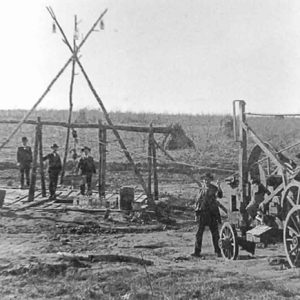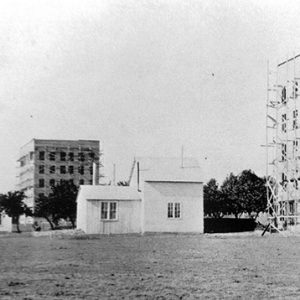calsfoundation@cals.org
Kruse Gold Mine
William (Will) Henry Kruse (1860–1925) sought gold ore deposits in Rogers (Benton County) on his father’s eighty-acre farm. His hunt for the precious metal was triggered neither by scientific nor geological verification but rather inspired by psychic revelations he combined with automatic writings pointing him to a precise site where he believed wholeheartedly that he would find enough gold to end world misery. To this end, he established Kruse Gold Mine and spent the remainder of his life trying to fulfill the renderings of his visualizations.
Will Kruse was born in Ohio, though his family moved to Le Sueur, Minnesota, the following year. In 1883, his father, Henry Kruse, purchased an eighty-acre tract in Rogers, eventually moving there in the fall of 1887. Around the turn of the century, Will Kruse, who owned a mercantile business in Le Sueur, moved to Minneapolis, Minnesota, and began experiencing “in broad-daylight” what he described as “indistinct ideas” that “would form in his mind.” Unable to divest himself of such visualizations, Kruse claimed that once he “ceased battling them they became clear.” With eyes closed and pen in hand, he experienced visions that prompted predictions, first of a world at war and later of “mines so rich in gold that there would be plenty for all, mines so great that the world could be economically reconstructed after the ravages of war and prosperity greater than before could be restored,” according to Kruse’s friend C. S. Fowler.
Chronic visions and voices revealed to Kruse that he should look on his father’s farm under a “wild apple tree sapling” to find gold. Family members could not find the spot, so he traveled to Rogers in August 1902 and found the sapling himself. Digging after midnight by lantern light, and filled with large expectation but little experience, Kruse found rock seven feet down. An assayer’s analysis of his samples revealed faint traces of gold. More samples brought the same conclusion; it lacked profitable worth. Denouncing their methodology and results, Kruse experienced new visions illuminating a new metallurgy test, making a determination by his own hand that gold was present at overwhelming values.
Gold mining operations officially kicked off on September 15, 1905, with a procession of workers to the mine from Kruse’s brother-in-law’s downtown mercantile store, L. M. Proctor & Company, led by the Rogers Cornet Band playing “Silver Threads among the Gold” and “In the Shade of the Old Apple Tree.” His family generally supported his efforts. Thirty men and seven horse teams were hired; smelters, multiple mineshafts, and a tower were eventually constructed. One day’s salary outlay was sixty-six dollars, a high sum for that period. Daily visitors came to watch, speculate, and mock the sensibility of Kruse. Fourteen mining operations were established, but no vein of gold was discovered. Kruse, his wife, and daughter returned to Minneapolis, while brother-in-law J. P. Huber stayed on to run the mine. Bags of earth from the mine were shipped by train to East St. Louis, Illinois, with the last load dumped beside the tracks when shipping charges went unpaid. L. M. Proctor & Company went bankrupt in 1909. Kruse was working with the laboratories of the Clark Mining Company of Butte, Montana, “on a process for handling the mineral found on his farm” when he died on December 12, 1925, according to the Benton County Record. His death finally ended the intervals of on-and-off work at the mine, which for all practical purposes had stalled around 1912.
Where some might have sought to line their own pockets with gold at the expense of others, Kruse never did. The Kruse Gold Mine foundation sought to end social problems through shared wealth, but public investment was never offered—was even publicly denounced—as Kruse claimed he would never sell stock in the company. Kruse wrestled and struggled with the telepathic occurrences, trying to come to terms with his intermediary role. His motivation of relieving world destitution was never achieved, but he, his family, and friends faced such a fate when the revelations were never realized.
For additional information:
“Big Time Out at Kruse’s.” Rogers Democrat. October 18, 1905, p. 3.
Black, J. Dickson. “Kruse’s Gold Mine.” In Beaver Lake Area Past & Present. Rogers, AR: Timberwolf Publishing, 1979.
“Digging for Gold.” Rogers Democrat. September 13, 1905, p. 3.
Emery, Robert C. “Vision Leads Minneapolitan to Mine; Gold Pledged to Relieve World Misery.” Minneapolis Morning Tribune. July 8, 1917, p. 4A.
Funk, Erwin. “Recalling the Kruse Gold Mine.” Benton County Pioneer 4 (November 1958): 10–12.
Hales, James. “Remembering Rogers 1881–2006: The Incredible Story of the Kruse Gold Mine.” Rogers Hometown News. January 7, 2009, p. 2.
“The Kruse Gold Mine.” Rogers Democrat. October 31, 1905, p. 4.
Mitchell, Dorothy. “The Rogers Gold Mine.” Ozarks Mountaineer 19 (May 1971): 18–19.
John Spurgeon
Bella Vista, Arkansas
 Post-Reconstruction through the Gilded Age, 1875 through 1900
Post-Reconstruction through the Gilded Age, 1875 through 1900 Kruse Gold Mine
Kruse Gold Mine  Kruse Mine Buildings
Kruse Mine Buildings 




Comments
No comments on this entry yet.